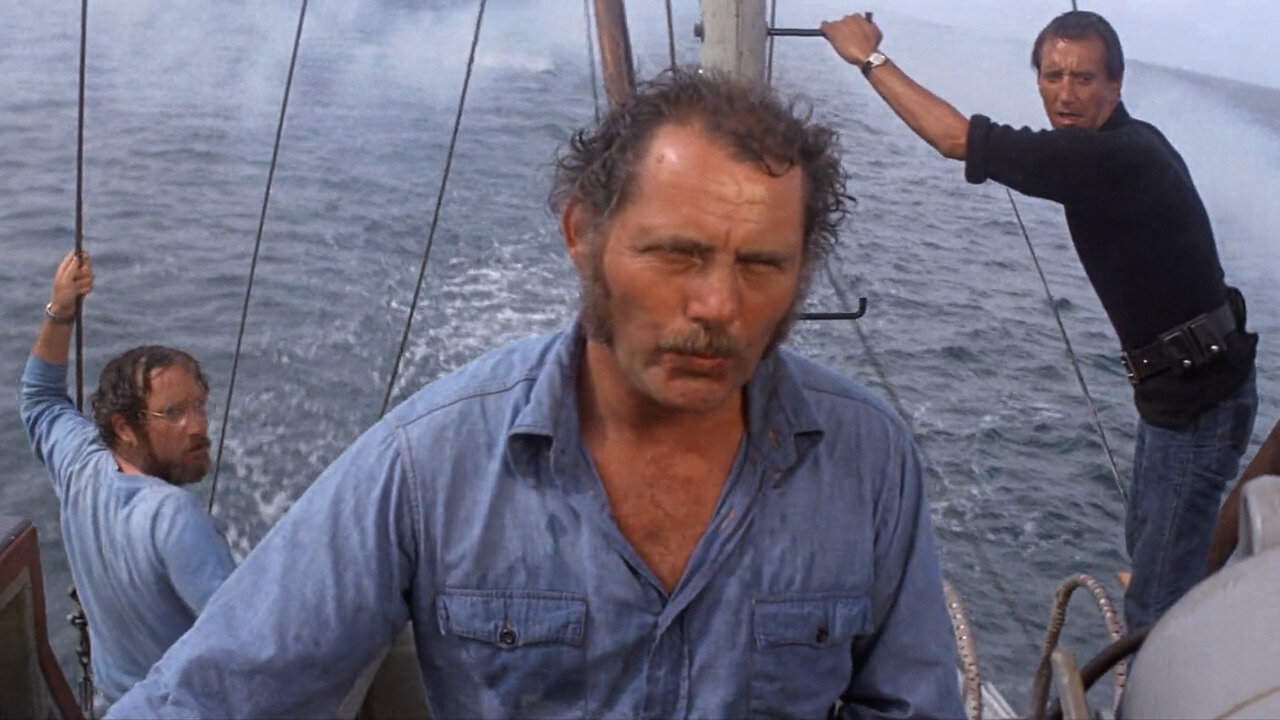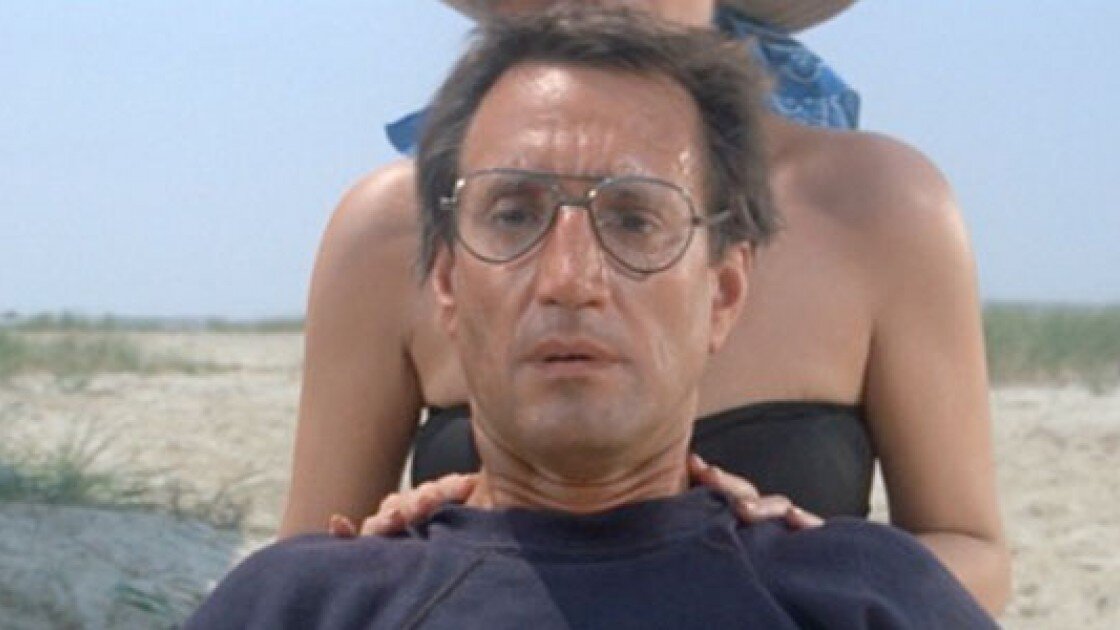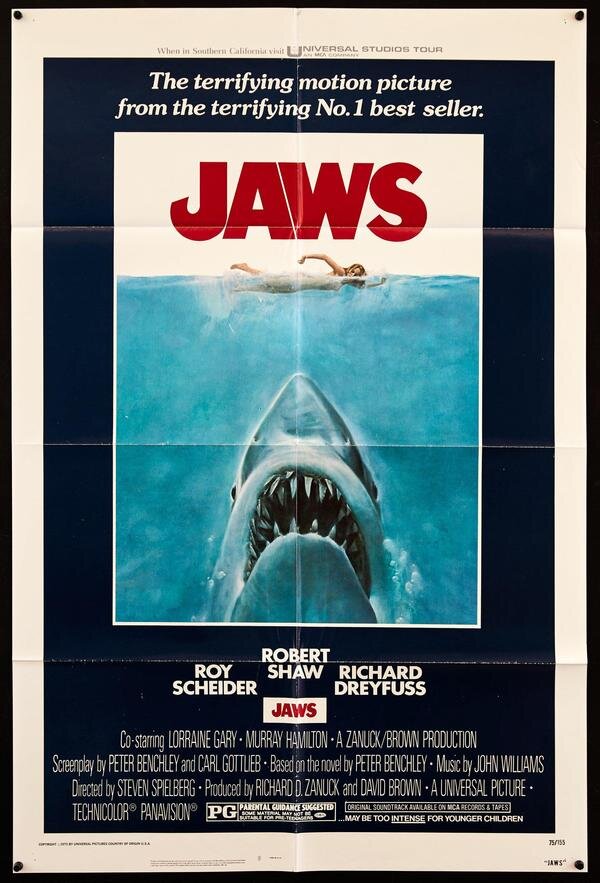Episode 10—Jaws: Great White Boy Summer
“I feel offended on behalf of sharks… anti-shark, anti-lawyer propaganda.”
Bruce the Shark, the villain of Jaws, was a major mechanical hurdle for the film. The difficulties he posed tripled the production schedule and led Spielberg to often hide the monster, thereby cultivating an artistic, Hitchcockian suspense for his summer blockbuster (Universal).
“There are too many captains on this island.” Shark expert Dr. Matt Hooper, played by Richard Dreyfuss (left), and gristled fisherman Quint, played by Robert Shaw (center), come together to help police chief Martin Brody, played by Roy Scheider (right), defeat the great white shark terrorizing Amity Island on the Fourth of July (Universal).
“Jaws was so much better than I remembered, but watching it again, I saw it totally differently...Especially after a year like 2020 that was so transformative and changed so many things, I never thought that rethinking Jaws was going to be one of them. ”
When Brody first witnesses a shark attack on the beach, the cinematography enhances the sense of terror with a technique called the dolly zoom. The camera physically moves outward (or dollies) and, at the same time, the lens zooms inward (Universal).
A classic long take in Jaws shows Chief Brody (far left) facing the obstacle of local political and business interests standing in the way of his singular mission of safety for the citizens (Universal).
The scene that Annee fully believed was the most famous of the film—the scar conversation—shows the antagonism between Quint (left) and Hooper (right) transform into drunken, hypermasculine, competitive bonding (Universal).
Original 1975 movie poster for Steven Spielberg’s Jaws (Universal).
Filled with iconic music, shots, and quotes, Jaws (1975) is a film you feel you already know well, but trust us—it’s worth revisiting. Directed by a 27 year old (!) Steven Spielberg, this shark attack movie is considered the first ever “summer blockbuster.” In plumping the depths of this film, we found high quality cinematic craftsmanship and surprisingly prescient themes on the destructive American norms of commercialism, terrorism, and masculinity. 🇺🇸🦈💪
In the second installment of our summer series, we’re taking a bite out of Jaws. The sisters examine the idea of the “summer blockbuster”, analyze the unexpected artistry of the film’s music, editing, and cinematography, and contemplate the movie as a metaphor for the great American tradition of predatory capitalism.
Show Notes
Film Synopsis
A great white shark kills several people and creates terror during peak tourist season in a Massachusetts beach town. An unlikely trio of men team up to destroy the shark before the Fourth of July weekend: the chief of police, Roy Scheider’s Martin Brody, an experienced fisherman, Robert Shaw’s Quint, and young scientist, Richard Dreyfuss’ Matt Hooper.
Jaws, directed by Steven Spielberg, screenplay by Peter Benchley & Carl Gottlieb, edited by Verna Fields. Starring Roy Scheider, Richard Dreyfuss, and Robert Shaw.
References
Jaws (1974) novel by Peter Benchley
Come and See (1985)
20,000 Leagues Under the Sea (1954)
Fiddler on the Roof (1971)
Valley of the Dolls (1967)
Dawson’s Creek (1998-2003)
The Color Purple (1985)
Schindler's List (1993)
Jurassic Park (1993)
Amistad (1997)
Saving Private Ryan (1998)
The Woman in the Window (1944)
Moby Dick (1956) (with Gregory Peck)
Moby-Dick (1851) novel by Herman Melville
Long take (which Annee mistakenly calls a long shot, but means to call a long take!)
1917 (2019)
Touch of Evil (1958)
Boogie Nights (1997)
La Haine (1995)
Vertigo (1958)
Star Trek: The Original Series (1966-1969) - Captain Kirk, Spock, and Bones
Zodiac (2007)
Independence Day (1996)
Transformers (2007)
Recommendations
Jessee: The Host (2006)
Frankee: The Birds (1963) and Letter Never Sent (1960)
Annee: Edited By (a survey of women film editors) and Moby Dick Big Read








